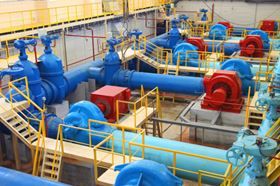5 Ways to Improve Water Treatment Plant Efficiency
Published on by Water Network Research, Official research team of The Water Network in Business
Against the backdrop of the global water crisis, the pressure for municipalities to efficiently treat water is greater than ever.
Water treatment plant operators should regularly analyze the plant’s water treatment performance and ensure systems are operating with the most efficient equipment and technology.
When water treatment plants are not operating efficiently, it can be extremely costly. The combination of inefficient and older pumping and process equipment, combined with outdated water management practices can result in higher operating costs and lower revenue collected, which can negatively impact a treatment plant.
The five steps outlined below can help water treatment plants to achieve better water efficiency and realize potential cost savings by reducing water waste.
- Conduct a self-assessment
Benchmarking has become a key practice in the industry, to set, promote and achieve performance targets. It not only helps managers and regulators identify historical trends, it also helps determine today’s baseline performance and quantify relative performance across utilities to plan for tomorrow and beyond.
Water treatment plant operators should begin by taking the Water Resource Foundation’s (WRF) self-assessment, which is part of the Performance Benchmarking for Effectively Managed Water Utilities report. The self-assessment is a useful asset for utilities to identify gaps in performance and develop strategies to reduce those gaps.
- Evaluate technology
Armed with an understanding of the effectiveness of current water practices, the next step is to evaluate the technology used for producing water.
For example, most surface water treatment plants have a water filtration process, which can easily consume large quantities of water and energy. For this reason, it’s important to conduct a technology audit to ensure that infrastructure is operating efficiently.
- Perform a pump audit
Many of the process technologies used for water involve pumps. Traditional practice, especially in plants which are ten years and older, is to design pumps based on the peak plant flow, when in reality these pumps operate at a variable flow, based on seasonality and system demand. For this reason, many pumps are oversized.
Constant speed pumps that operate in an on-and-off mode use more water than required, which leads to water and energy waste. For this reason, plants should retrofit their constant speed pumps with variable frequency drives (VFDs) to reduce water waste and energy consumption and avoid pump wear and tear from repeated on-off cycling. VFDs can reduce a pump’s energy use by as much as 50%, which also means reducing water consumption.

Plants should retrofit their constant speed pumps with VFDs to reduce water waste and energy consumption.
- Install smart technology
When it comes to water management practices, water treatment plants should consider implementing smart metering technology to monitor their distribution network. This can minimize non-revenue water waste.
Smart technologies like Automated Meter Reading (AMR) solutions and Advanced Metering Infrastructure (AMI) help utilities benchmark performance and optimize their infrastructure.
AMR automatically gathers consumption, diagnostic and status information from water metres without the need for a manual metre read, thus streamlining and improving the accuracy of data collection. The information, coupled with analytics, can help utilities and their customers better manage water use.
AMI enables utilities to make decisions based on performance and insights in near real time. It is a more robust solution than AMR, which includes smart metres, communication networks and data management systems that enable two-way communication between utilities and customers.
Strategic deployment of AMR and AMI technology is an effective way to optimize performance. With the data collected from these systems, utilities can account for every drop of water. Immediately following its system deployment, one utility in the Northeast region of the United States caught a leak that was hemorrhaging 200,000 gals of treated water per day. That equals the amount of water used daily by 2,500 people.
- Review the data
The last step is to access and analyze the data to evaluate infrastructure performance and identify what adjustments are needed to further improve efficiencies. Because many water treatment facilities were installed without much thought about data acquisition, it’s important for treatment plant managers to ensure they are measuring and monitoring the right efficiency parameters.
Essential efficiency parameters include monitoring for leaks in the distribution network, backwash water rates tied to filter quality output, sludge thickening rates and smart pump operation using VFDs.
Water treatment plant operators should consistently evaluate their water management practices to ensure that the plant is operating efficiently, thus minimizing energy costs and improving water conservation efforts.
Source: World Pumps
Media
Taxonomy
- Treatment Plants
- Technology
- Optimization
- Wastewater Treatment
- Water Treatment Solutions
- Water Utility
- Network Optimisation
- Pumps
- Utility Management
- Utility Pipe Network